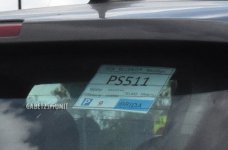Mopar Insiders Forum
You are using an out of date browser. It may not display this or other websites correctly.
You should upgrade or use an alternative browser.
You should upgrade or use an alternative browser.
Jeep Compass 1.5 turbo hybrid caught on the road
- Thread starter Bili
- Start date
Deckard Cain
Well-known member
- Joined
- Oct 8, 2018
- Messages
- 702
- Reaction score
- 539
- Points
- 93
Awesome!!
patfromigh
Well-known member
Is it the Punch unit or something more recognized?... mated to a 48 Volt hybrid DCT.
- Joined
- May 4, 2018
- Messages
- 1,858
- Reaction score
- 1,562
- Points
- 113
Punch is not DCT. How many times I need to repeat it? BTW, Punch could be ready in late 2023.Is it the Punch unit or something more recognized?
Not go mention that powertrain development is very, very long in duration.
Magna/Getrag 7 speed wet DCT.
patfromigh
Well-known member
Technically it isn't, but press reports describe it that way. With electric "creep" a DCT like the Magna would be acceptable to American drivers.Punch is not DCT. How many times I need to repeat it? BTW, Punch could be ready in late 2023.
Archknight
Active member
- Joined
- Dec 23, 2018
- Messages
- 126
- Reaction score
- 119
- Points
- 43
I do believe this engine will be linked to the 9AT in the NA market. They wouldn't spend all this time developing the powertrain so similar to 2.0T eTorque, if it couldn't be used with a transmission for this market. Besides that, most other markets have already gotten their 2022 MY versions of the Compass with the 1.3T upgrade, the US has been asking for more power/performance since the its introduction. I'm interested to see how many products end up with this engine. I'm sure the Hornet is also getting a variation of this engine.
- Joined
- May 4, 2018
- Messages
- 1,858
- Reaction score
- 1,562
- Points
- 113
@Archknight
No, it's not similar to eTorque. Why? It's not a belt driven (BSG) mild hybrid system.
Electric motor embedded in transmission is essential part of it.
In operation it's similar to HEV systems, to P2 HEV systems. The only major difference is operating voltage which in this case allows car mechanics to work on a car with regular tools unlike with high voltage hybrids.
I had a hard time figuring which high voltage HEV system is most similar to this one. Of course it must be offered on North American market.
New Ford Explorer HEV is the most similar. It's a P2 HEV.
No, it's not similar to eTorque. Why? It's not a belt driven (BSG) mild hybrid system.
Electric motor embedded in transmission is essential part of it.
In operation it's similar to HEV systems, to P2 HEV systems. The only major difference is operating voltage which in this case allows car mechanics to work on a car with regular tools unlike with high voltage hybrids.
I had a hard time figuring which high voltage HEV system is most similar to this one. Of course it must be offered on North American market.
New Ford Explorer HEV is the most similar. It's a P2 HEV.
Archknight
Active member
- Joined
- Dec 23, 2018
- Messages
- 126
- Reaction score
- 119
- Points
- 43
@Archknight
No, it's not similar to eTorque. Why? It's not a belt driven (BSG) mild hybrid system.
Electric motor embedded in transmission is essential part of it.
In operation it's similar to HEV systems, to P2 HEV systems. The only major difference is operating voltage which in this case allows car mechanics to work on a car with regular tools unlike with high voltage hybrids.
I had a hard time figuring which high voltage HEV system is most similar to this one. Of course it must be offered on North American market.
New Ford Explorer HEV is the most similar. It's a P2 HEV.
So all this from the article is wrong and you know for sure:
The new 1.5-liter mild-hybrid electric vehicle (mHEV, also known as a 48V HEV in Europe) powertrain, will be similar to the eTorque system found on the Ram 1500 pickup. The mild-hybrid system replaces the traditional alternator on the engine with a belt-driven starter generator (BSG) unit that performs several functions. The motor-generator unit works with a 48-volt battery pack to enable quick and seamless Stop/Start function, short-duration torque addition to the engine crankshaft in certain driving situations, and brake energy regeneration, which improves responsiveness and efficiency.
bill burke
Well-known member
- Joined
- Dec 9, 2020
- Messages
- 1,357
- Reaction score
- 1,361
- Points
- 113
This system called E-Torque is very appealing to me, someone who has little interest in electric vehicles. It maintains the best attributes of gasoline powered vehicles and yet offers reliable battery powered features that have performance and environmental features that make sense and have more reliability. I have postponed buying a next generation Grand Cherokee in hopes this system is offered in the near future. Until then or after two years, I’ll stick with my outstanding Cherokee V-6.
bill burke
Well-known member
- Joined
- Dec 9, 2020
- Messages
- 1,357
- Reaction score
- 1,361
- Points
- 113
Just carefully read the comment on this system and the E-Torque and it still appeals to me, if the transmission is refined and reliable enough, a very significant factor indeed. Nice to see people with more technical knowledge share that with readers and educate them too. Very interesting discussion here.
patfromigh
Well-known member
The first half of this video is the Magna 48V DCT to be used in the Euro Compass. The last part is a 400V plugin hybrid DCT not used in any Stellantis branded vehicle. I think the high voltage unit is used on some BMW models. I know BMW already uses the 48V one.
- Joined
- May 4, 2018
- Messages
- 1,858
- Reaction score
- 1,562
- Points
- 113
No, BMW is using regular DCT without electric motors. Basically it's the same transmission. Wet dual clutch 7 speed transmission.I think the high voltage unit is used on some BMW models. I know BMW already uses the 48V one.
BMW plans to use electrified Getrag DCT but currently it's not using it.
For BMW's FWD based PHEV they have similar solution as on the Jeep Compass or Renegade. E-axle at the rear.
TripleT
Well-known member
- Joined
- Jun 27, 2018
- Messages
- 3,859
- Reaction score
- 3,835
- Points
- 113
Pretty sure the distinction between Hybrid and Mild Hybrid will be battery and voltage not the bolt on solution used in the 3.6 and 5.7.
Mild hybrids and just as stepping stone to completely integrated systems, with the motors in transmission.
12v redundant starters have been on the clock for about 2 years. They won't be around much more. It will be interesting to see how the replacement battery industry responds.
Mild hybrids and just as stepping stone to completely integrated systems, with the motors in transmission.
12v redundant starters have been on the clock for about 2 years. They won't be around much more. It will be interesting to see how the replacement battery industry responds.
- Joined
- May 4, 2018
- Messages
- 1,858
- Reaction score
- 1,562
- Points
- 113
Pretty sure the distinction between Hybrid and Mild Hybrid will be battery and voltage not the bolt on solution used in the 3.6 and 5.7.
Hybrid or full hybrid is thing of the past. At least European carmakers and suppliers agree on it.
We will have 48V full hybrids and high voltage plug in hybrids.
EVs from all manufacturers have a standard 12v lead-acid battery in them, as do High-voltage hybrids. Lithium batteries can’t handle cold, so you use the lead-acid pack to provide heat to warm them up.12v redundant starters have been on the clock for about 2 years. They won't be around much more. It will be interesting to see how the replacement battery industry responds.
TripleT
Well-known member
- Joined
- Jun 27, 2018
- Messages
- 3,859
- Reaction score
- 3,835
- Points
- 113
EVs from all manufacturers have a standard 12v lead-acid battery in them, as do High-voltage hybrids. Lithium batteries can’t handle cold, so you use the lead-acid pack to provide heat to warm them up.
they are developing heat management system that overcome that in the latest battery. It won't be long until it obsolete tech... It is on the clock.


